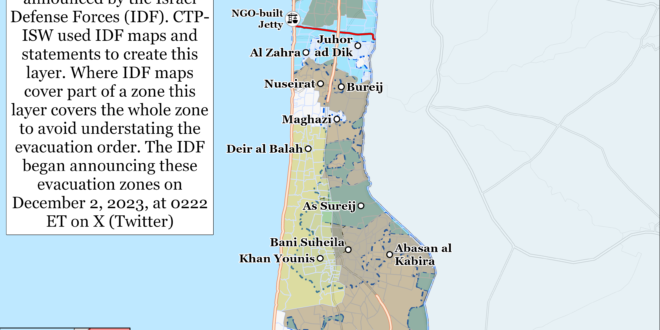Hezbollah’s October 13 drone attack targeting an IDF base is likely part of an effort to impose costs on Israel as Hezbollah faces operational challenges in southern Lebanon. Hezbollah conducted a drone attack on October 13 targeting a training camp south of Haifa for the IDF 1st Infantry Brigade that killed four IDF soldiers and injured 61 others.[i] Hezbollah said that the strike was targeting soldiers as they prepared for operations in Lebanon, and the IDF assessed that Hezbollah deliberately targeted an IDF dining facility during a period in which Hezbollah expected soldiers to be eating.[ii] This strike is likely an effort to impose costs on Israel at a time when Hezbollah can conduct only limited defensive operations in southern Lebanon. The Israeli air campaign has severely disrupted Hezbollah’s command-and-control structures, and Israeli forces have observed Hezbollah fighters fleeing or only observing Israeli troops from a distance rather than decisively engaging IDF units.[iii] The IDF continues to seize terrain and towns, demonstrating that it can act with impunity in southern Lebanon.[iv] Hezbollah attacks into Israel allow it to claim that it is ”resisting” Israeli forces despite being unable or unwilling to defend southern Lebanon.[v]
This attack is part of a possible broader campaign that Hezbollah described on October 12. Hezbollah claimed on October 12 that its fighters continued to target IDF rear positions in northern Israel and “support lines” as part of its defense against Israel’s ground operation in southern Lebanon.[vi] Attacks on IDF support elements are meant to degrade the IDF’s ability to conduct effective ground operations, though it is unclear what military effect these attacks will have if any at all. Hezbollah’s decision to target a training camp for the 1st Infantry Brigade—a unit currently operating in southern Lebanon—likely falls within this framework.[vii] These attacks also could have an outsized effect in the Israeli domestic political space as well, and Hezbollah may calculate that continued attacks on rear IDF bases that kill even small numbers of IDF soldiers will cause Israeli public support for the ground campaign in Lebanon to decline. Hezbollah’s October 13 attack demonstrates that Hezbollah can precisely target IDF rear positions in northern Israel. The attack also demonstrates that Hezbollah‘s command-and-control network is sufficiently intact to order and execute these sorts of coordinated rocket and missile attacks (see below).
Hezbollah has almost certainly adopted a new tactic in an attempt to evade Israeli air defenses. The development of this tactic is a byproduct of Hezbollah’s year-long learning process during its fires campaign targeting civilian and military sites in northern Israel since October 2023. A preliminary IDF Air Force investigation indicated that Hezbollah launched a combined offensive of drones, rockets, and three precision missiles targeting Haifa at the same time it launched the drone targeting Binyamina.[viii] The IDF Navy and Iron Dome intercepted two of the drones near Nahariya and Acre but detection systems lost track of a third drone, a Shahed 107—which ultimately impacted in Binyamina.[ix] This tactic of using imprecise indirect fires to distract air defenses and then using precision weapons to strike targets has become common across Iran and its Axis of Resistance in recent years. Hezbollah has used this tactic to distract Israeli air defenses on numerous occasions to allow low-flying drones to enter northern Israel during its year-long campaign.[x] These drone attacks have previously proved difficult for Israeli air defenses to intercept. [xi]
Hezbollah likely attempted to replicate the successful October 13 attack by launching three surface-to-surface missiles targeting central Israel at the same time it launched dozens of rockets toward northern Israel on October 14.[xii] All three of these missiles were intercepted, but the missiles caused 182 red alerts across central Israel.[xiii]
The IDF vowed to respond by targeting Hezbollah’s drone unit and drone production infrastructure in response to the October 13 attack. Israeli Defense Minister Yoav Gallant told US Secretary of Defense Lloyd Austin on October 13 that Israel would engage in a “forceful response” against Hezbollah.[xiv] Israeli Army Radio reported that IDF Air Force commander Major General Tomer Bar instructed the IDF to prioritize airstrikes targeting Hezbollah’s drone unit, which is responsible for drone production and operations.[xv] Bar said that the IDF Air Force set the goal to target every Hezbollah fighter, “from junior to senior,” in Hezbollah’s drone unit.[xvi] Israeli airstrikes have primarily targeted Hezbollah’s rocket and missile capabilities but have occasionally targeted Hezbollah drone assets. The IDF recently struck drone warehouses in southern Lebanon on October 8 and 9, for example.[xvii]
Iranian media reported that Russia will launch two satellites on Iran’s behalf after Iran sent the two satellites to Russia on October 11.[xviii] Iran sent a high-resolution imaging ”Kowsar” satellite and a small ”Hodhod” communications satellite to Russia.[xix] Russia was originally scheduled to launch these satellites in December 2023 but was delayed.[xx] Russia previously launched two Iranian satellites in August 2022 and February 2024.[xxi] Russia will launch these satellites using the Soyuz space launch vehicle, which Russia also used in the February 2024 launch.[xxii] Iran could use the ”Kowsar” satellite to collect imagery on US or allied troop positions and bases in the region. CTP-ISW has not observed acknowledgment of the satellite delivery in Russian media.
An unspecified Islamic Revolutionary Guards Corps (IRGC) Quds Force member told Kuwait-based newspaper Al Jarida that Iranian Supreme Leader Ali Khamenei appointed IRGC Quds Force Deputy Commander Mohammad Reza Fallah Zadeh to serve as an operational adviser to Lebanese Hezbollah.[xxiii] CTP-ISW cannot corroborate or verify this claim. The source claimed that Fallah Zadeh would help ”manage the current war” with Israel and secure logistical and communications support. The source reported that Fallah Zadeh will not advise Hezbollah in political matters or change the political structure of Hezbollah. Hezbollah has not announced its next Secretary General following airstrikes that killed Hassan Nasrallah and his presumed successor Hashem Safi el Din.[xxiv] Al Jarida has previously made unsubstantiated claims citing unspecified IRGC Quds Force officials that CTP-ISW also could not independently verify. No other reputable news organization independently reported similar claims corroborating al Jarida’s previous reports.
Iranian media published the full text of the “Development Plan for the Peaceful Use of Nuclear Technology” on October 14.[xxv] A parliamentary presidium member recently announced the plan on October 6.[xxvi] The plan calls for the establishment of an “Atomic Energy Council” comprised of 19 members, including the Iranian president and the ministers of energy, foreign affairs, and defense.[xxvii] The plan also stipulates that the National Development Fund must invest at least $1 billion in Iranian nuclear power projects annually.
Iran is continuing to coordinate with regional and Axis of Resistance leaders ahead of an expected Israeli retaliatory strike on Iran. Iranian Foreign Affairs Minister Abbas Araghchi traveled to Baghdad on October 13 to discuss the “special and dangerous conditions” in the Middle East with senior Iraqi officials.[xxviii] Araghchi may have warned Iraqi officials against allowing Israel to use Iraqi airspace to attack Iran. Iraqi Foreign Affairs Minister Fuad Hussein described “[Israel’s] exploitation of Iraqi airspace” to attack Iran as “completely unacceptable” during a press conference with Araghchi.[xxix] Iraqi President Abdul Latif al Rashid separately emphasized that Iraq “will never serve as a launching pad” for attacking Iran during a meeting with Araghchi.[xxx] Western media previously reported that Israel likely used Iraqi airspace to attack Iran on April 18 in retaliation for the April 13 Iranian drone and missile attack on Israel.[xxxi] Previous Iraqi governments have also warned Iran and the United States against using Iraq as a ”launching pad” for regional conflict, though these governments in practice are unable to prevent Iranian-backed groups in particular from using Iraqi territory to target US forces and Israel.[xxxii]
Araghchi separately met with senior Omani officials and senior Houthi official Mohammad Abdulsalam in Muscat, Oman, on October 13.[xxxiii] Araghchi told reporters in Muscat that Iran has stopped indirect talks with the United States, likely referring to indirect talks that US and Iranian officials have held in Oman in recent months to try to avoid escalation in the region.[xxxiv] Oman and Iraq have historically served as intermediaries between Iran and the United States, and Araghchi may have called on the Omani and Iraqi governments to pressure the United States to restrain Israel’s response to the October 1 Iranian attack.[xxxv] Unspecified sources told CNN on October 12 that Iranian officials have been conducting “urgent diplomacy” with Middle Eastern countries to try to reduce the scale of Israel’s retaliation.[xxxvi] The sources added that the Iranian regime is “extremely nervous” about the retaliation and is “uncertain” that the United States can convince Israel not to strike Iranian nuclear and energy infrastructure.[xxxvii]
Key Takeaways:
- Hezbollah Drone Strike in Israel: Hezbollah’s October 13 drone attack targeting an IDF base is likely part of an effort to impose costs on Israel as Hezbollah faces operational challenges in southern Lebanon. This strike is likely an effort to impose costs on Israel at a time when Hezbollah can conduct only limited defensive operations in southern Lebanon.
- Hezbollah Tactical Adaptation: Hezbollah has almost certainly adopted a new tactic in an attempt to evade Israeli air defenses. The development of this tactic is a byproduct of Hezbollah’s year-long learning process during its fires campaign targeting civilian and military sites in northern Israel since October 2023.
- Iran-Russia: Iranian media reported that Russia will launch two satellites on Iran’s behalf after Iran sent the two satellites to Russia on October 11.
- Iranian Support to Hezbollah: An unspecified Islamic Revolutionary Guards Corps (IRGC) Quds Force member told Kuwait-based newspaper Al Jarida that Iranian Supreme Leader Ali Khamenei appointed IRGC Quds Force Deputy Commander Mohammad Reza Fallah Zadeh to serve as an operational adviser to Lebanese Hezbollah. CTP-ISW cannot corroborate or verify this claim.
- Iranian Preparations for Israeli Strike: Iran is continuing to coordinate with regional and Axis of Resistance leaders ahead of an expected Israeli retaliatory strike on Iran.
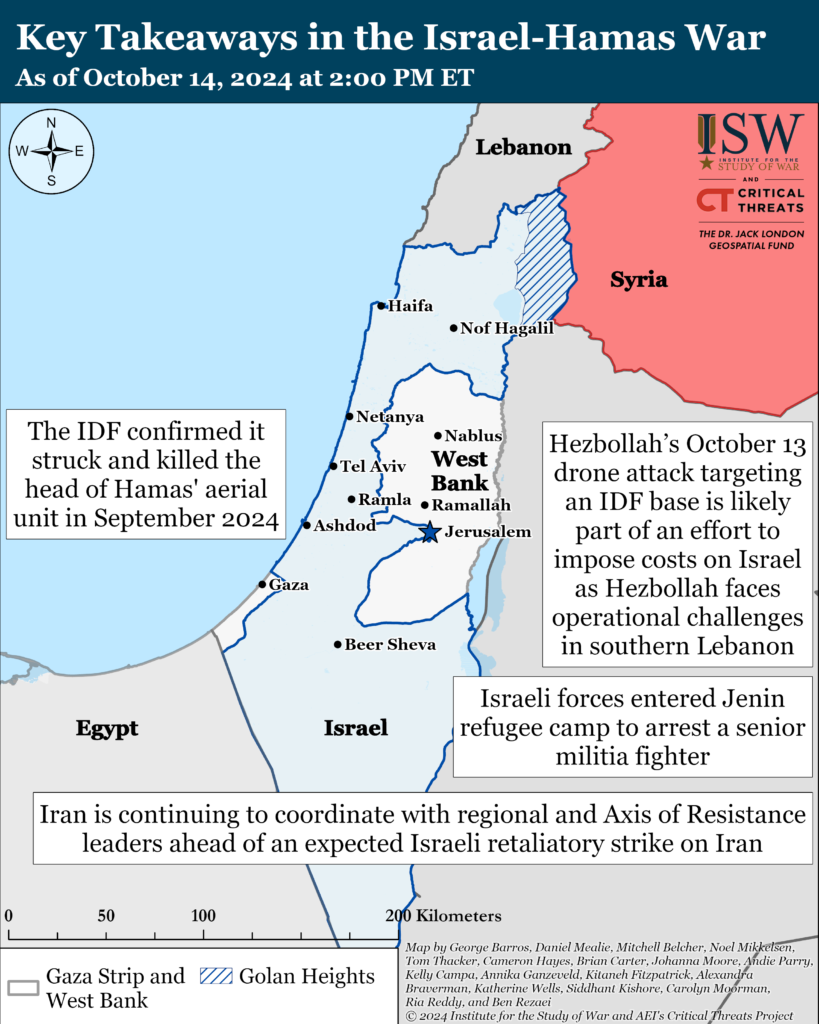
Gaza Strip
Axis of Resistance objectives:
Erode the will of the Israeli political establishment and the public to sustain clearing operations in the Gaza Strip
Reestablish Hamas as the governing authority in the Gaza Strip
The IDF announced on October 14 that the IDF Air Force had struck and killed the head of Hamas’ aerial unit in the Gaza Strip, Samer Ismail Hader Abu Daqa, in September 2024.[xxxviii] Abu Daqa was responsible for the infiltration of drones into Israeli territory, including during the October 7 attacks.[xxxix] The IDF Air Force struck in the al Mawasi humanitarian zone in Kahn Younis on September 9 targeting three senior Hamas commanders, including Daqa.[xl]
Humanitarian aid groups began the second round of the mass polio vaccination campaign in the Gaza Strip on October 14.[xli] The Gazan Ministry of Health announced on October 13 that this round of the campaign will consist of three phases that would start in Deir al Balah on October 14.[xlii] The other phases of the campaign will occur in Khan Younis and Rafah and then Gaza and the northern Gaza Strip. Humanitarian aid groups completed the first round on September 12.[xliii] Israel and Hamas both agreed to observe limited humanitarian pauses in designated areas of the central, southern, and northern Gaza Strip throughout the first round of the campaign.[xliv] Neither Hamas nor Israel have publicly agreed to observe limited humanitarian pauses for this round of the campaign at the time of this writing. UNRWA claimed that Israeli forces near the Nuseirat refugee camp fired several tank rounds on October 13 that hit a UNRWA school that humanitarian aid groups had planned to use as an immunization site during the second ground of the campaign.[xlv] UNRWA head Phillippe Lazzarini said that a UNRWA school in the central Gaza Strip recently hit by an Israeli airstrike was also to be used for the vaccination campaign.[xlvi]
The IDF 143rd, 162nd, and 252nd Divisions continued operations in the Gaza Strip on October 14.[xlvii] IDF forces killed fighters in combat operations and located weapons, warehouses, tunnel shafts, and unspecified infrastructure.
Hamas fired small arms and detonated an IED targeting Israeli armor north of Beit Lahia on October 13.[xlviii]
Hamas and Palestinian Islamic Jihad (PIJ) conducted multiple IED, mortar, and small arms attacks targeting Israeli personnel and armor both within Jabalia Camp and in areas surrounding the camp.[xlix] The IDF 162nd Division continues to conduct clearing operations in Jabalia.[l]
The al Aqsa Martyrs’ Brigades and the Popular Resistance Committees fired rockets targeting Israeli forces along the Netzarim Corridor on October 13.[li] The IDF 252nd Division operates along the Corridor.[lii]
The IDF Air Force struck a Hamas command-and-control site in the central Gaza Strip on October 13.[liii] The IDF said that Hamas fighters used the al Aqsa Martyrs’ Hospital in Deir al Balah to plan and conduct attacks targeting Israeli forces and Israeli territory. The IDF added that it took steps to minimize civilian casualties.[liv] The Wall Street Journal reported that the strike killed four Palestinians and injured around 40.[lv] The IDF last struck a Hamas command-and-control site based in the al Aqsa Martyrs’ Hosptial in Deir al Balah on October 6.[lvi]
The IDF said that a 401st Armored Brigade soldier was injured on October 13 by anti-tank fire targeting an armored force in the southern Gaza Strip.[lvii] The IDF Air Force struck Palestinian fighters who had fired an anti-tank guided missile targeting Israeli forces on October 14.[lviii] The IDF also said that a 460th Armored Brigade soldier died in battle in the southern Gaza Strip on October 14.[lix] Hamas fired a rocket-propelled grenade targeting an IDF tank east of Rafah on October 13.[lx] Hamas separately detonated an anti-personnel mine targeting Israeli forces east of Rafah on October 14.[lxi]
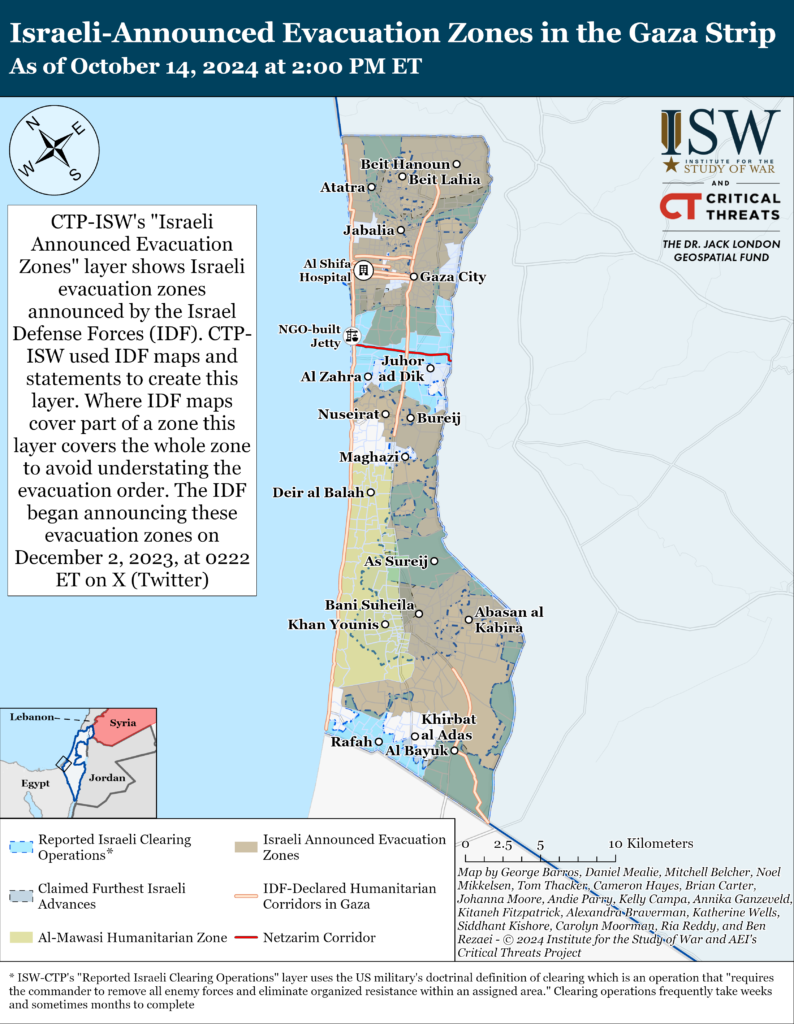
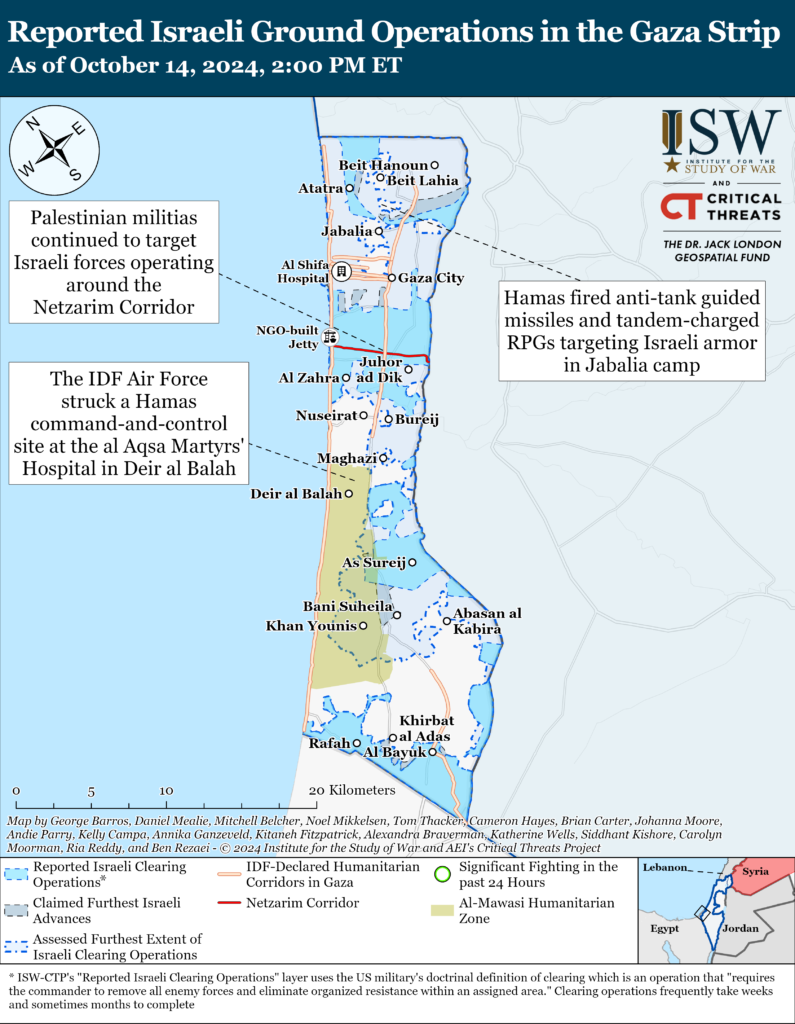
West Bank
Axis of Resistance objectives:
Establish the West Bank as a viable front against Israel
An Israeli Army Radio correspondent reported that Israeli forces entered “the heart of Jenin refugee camp” on October 14 to arrest a senior militia fighter.[lxii] The correspondent added that Israeli forces isolated the building and then forced the fighter to surrender.
Israeli forces engaged Palestinian fighters in at least three locations in Jenin since CTP-ISW’s last data cutoff on October 13.[lxiii] Palestinian Islamic Jihad (PIJ) and the al Aqsa Martyrs’ Brigades conducted multiple small arms and IED attacks targeting Israeli forces within Jenin refugee camp.[lxiv] PIJ also fired small arms and detonated an IED targeting Israeli forces and armor near the camp.[lxv]
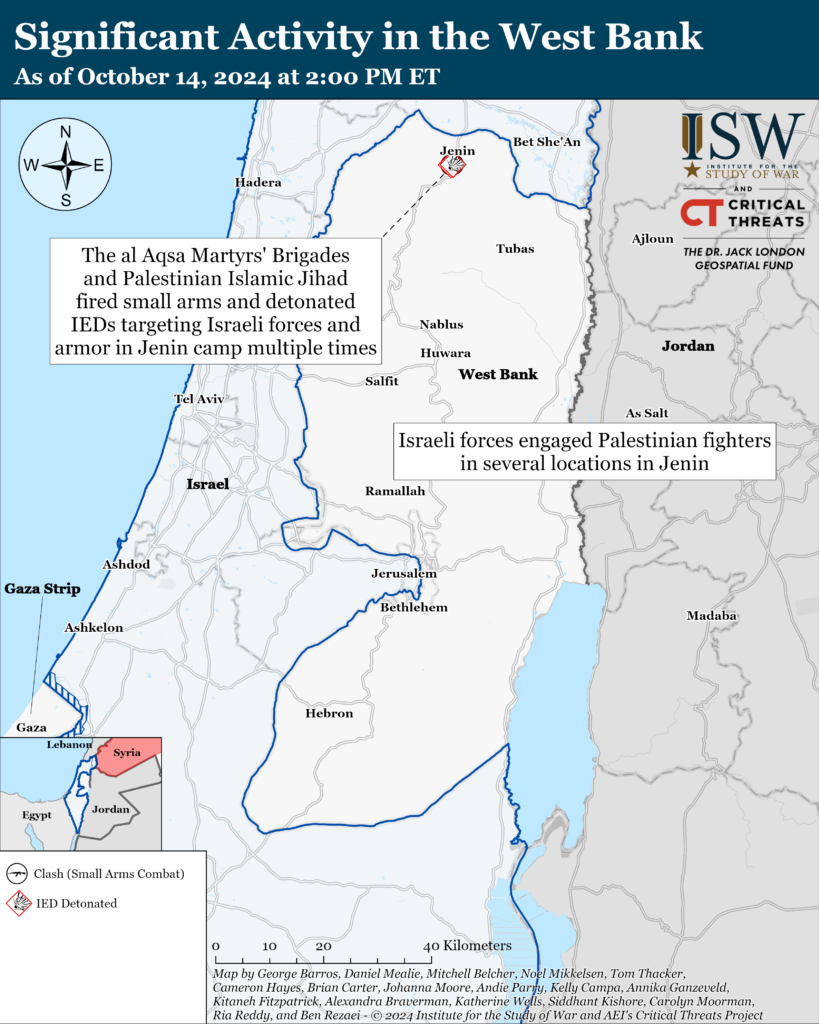
Northern Israel and Lebanon
Axis of Resistance objectives:
Prepare for an expanded and protracted conflict with Israel in the near term
Expel the United States from Syria
Hezbollah continued to engage Israeli forces near Aita al Shaab and Ramyeh in southern Lebanon on October 14.[lxvi] An unspecified IDF Division began operations in the area on October 13.[lxvii] Hezbollah targeted an Israeli armored personnel carrier with an anti-tank guided missile in Aita al Shaab and claimed that the attack killed and wounded Israeli soldiers.[lxviii] Hezbollah fighters also engaged Israeli forces with various types of machine guns, rockets, and mortars in Aita al Shaab.[lxix]
Hezbollah claimed to target Israeli forces attempting to enter Markaba in southeast Lebanon on October 14. Hezbollah targeted Israeli forces near the village with mortar and rocket fire.[lxx] Hezbollah-affiliated sources reported IDF armor movements near Markaba and other nearby border areas.[lxxi] The IDF began operating in Odaisseh, which is adjacent to Markaba, on October 1, but Hezbollah-affiliated sources reported that Israeli forces withdrew from Odaisseh on October 7.[lxxii]
The IDF 146th Reserve Division continued clearing operations in southwestern Lebanon on October 13.[lxxiii] The IDF 2nd Infantry Brigade (Res.) has located dozens of tunnel shafts and ammunition depots since beginning targeted operations in southwest Lebanon.[lxxiv] The brigade has killed several Hezbollah fighters, including at least five Hezbollah Radwan SOF fighters.[lxxv] An Israeli Army Radio journalist released footage of a Hezbollah command compound near Labbouneh on October 13.[lxxvi] Hezbollah targeted Israeli forces in Labbouneh with multiple rocket barrages.[lxxvii]
The IDF 91st Division continued clearing operations in southern Lebanon.[lxxviii] The IDF 8th Armored Brigade discovered a Hezbollah Rawdan SOF underground command post complex in ”the heart of a residential neighborhood.”[lxxix] The IDF said that the command post was fully stocked with weapons and supplies for Radwan fighters that they would need to complete a ground incursion into northern Israel.[lxxx] Israeli forces engaged a Hezbollah fighter barricaded in the complex.[lxxxi]
The IDF Arabic-language spokesperson called on civilians to evacuate immediately from 25 towns and villages in southern Lebanon on October 14.[lxxxii] Most of the towns are north of the Litani River.[lxxxiii] The spokesperson told residents that they should move north of the Awali River.
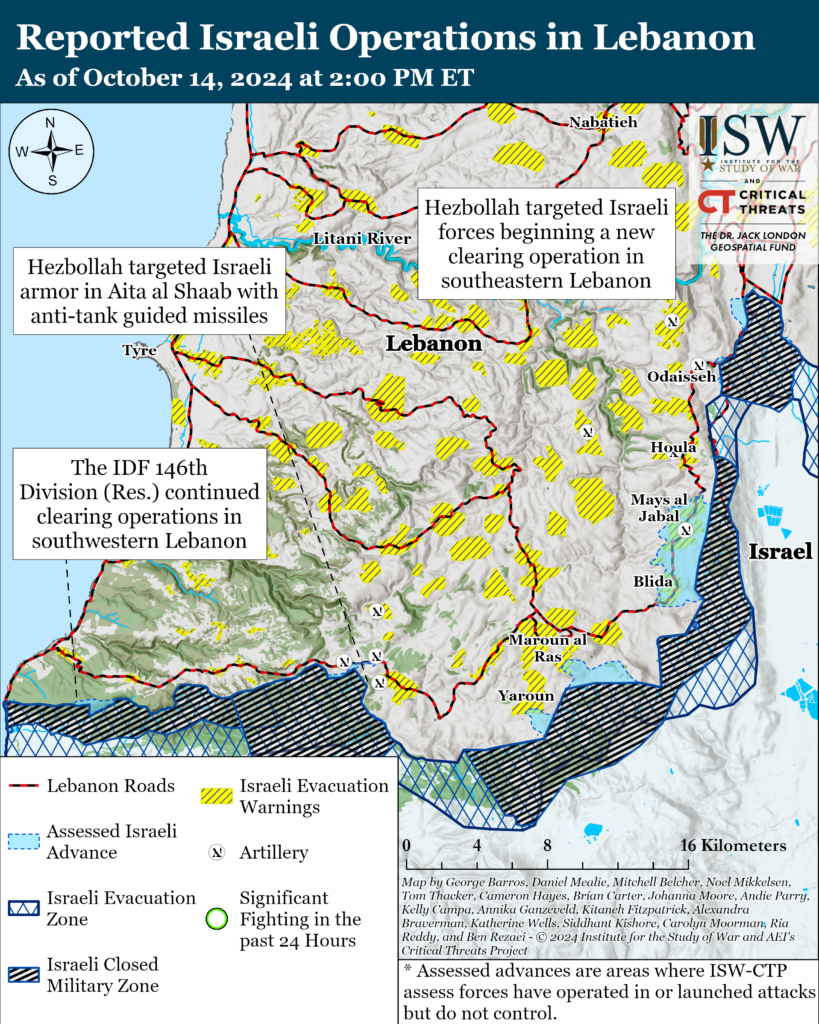
IDF continued an air campaign to degrade Hezbollah capabilities and leadership on October 14. The IDF Air Force struck about 200 Hezbollah targets in southern Lebanon and deep inside Lebanon over the past day.[lxxxiv] The strikes targeted rocket launchers, anti-tank guided missile launching positions, military buildings, and weapons depots.[lxxxv] Hezbollah has recently used some of the rocket launchers to target Israel.[lxxxvi] Unspecified CNN sources reported on October 13 that the IDF has paused targeting Beirut after conversations with the Biden Administration.[lxxxvii] Israeli Prime Minister Benjamin Netanyahu reiterated on October 14 that Israel would continue to target Hezbollah assets in Beirut.[lxxxviii] The IDF Air Force struck and killed Hezbollah Radwan SOF anti-tank missile unit commander Muhammad Kamal Naim in Nabatiyeh, southern Lebanon.[lxxxix] An Israeli airstrike also targeted Hezbollah member Ahmed Faqih near Tripoli, according to local Lebanese sources.[xc] The Lebanese Red Cross said that the strike killed at least 18.[xci] This strike is the second time that the IDF has targeted the Tripoli area during its air campaign.[xcii] Hezbollah does not have a strong support base in Tripoli.
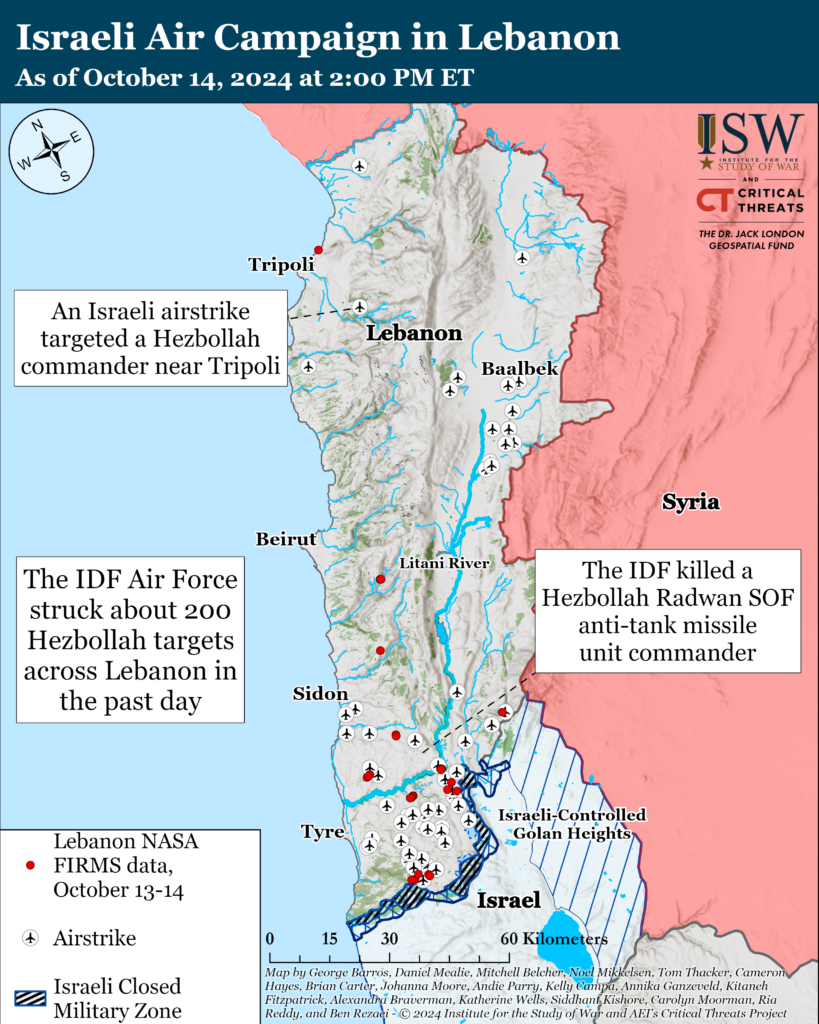
This map illustrates individual Israeli air and artillery strikes based on local Lebanese reporting. This map depicts strikes reported from 2:00pm ET on October 13to 2:00pm ET on October 14. This map is not exhaustive. CTP-ISW cannot independently verify the locations of Israeli strikes.
Hezbollah has conducted at least 30 attacks into Israel since CTP-ISW’s last data cutoff on October 13.[xciii] Hezbollah targeted IDF bases near Haifa and Netanya.[xciv] Hezbollah’s operations room issued a statement on October 11 that Hezbollah forces would gradually increase their rate of attack targeting Israeli towns and military bases ”deep” in Israel.[xcv] Hezbollah fired rockets and mortars in at least 18 separate attacks targeting Israeli positions along the Israel-Lebanon border.[xcvi] Hezbollah targeted Israeli forces in Manara six separate times.[xcvii]
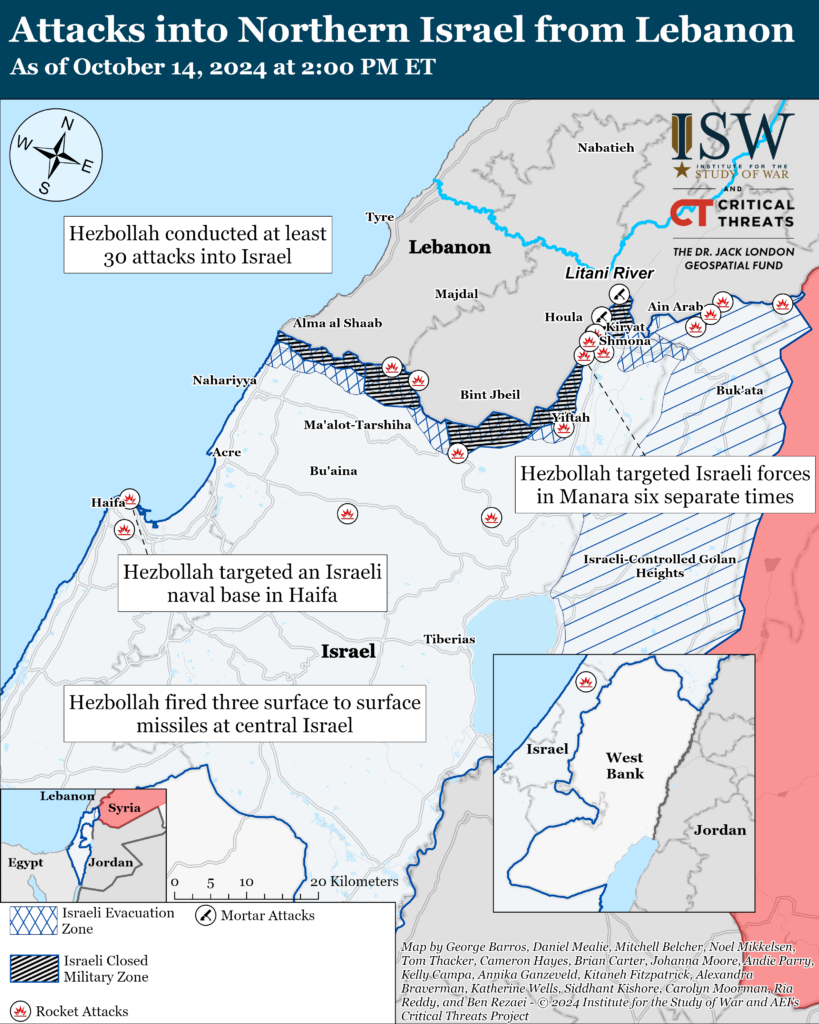
Iran and the Axis of Resistance
Iranian Parliament Speaker Mohammad Bagher Ghalibaf attended the 149th Inter-Parliamentary Union (IPU) Assembly in Geneva on October 13 to 17.[xcviii] Ghalibaf called on the international community to put pressure on the United States to restrain Israel in the Gaza Strip and Lebanon in his speech to the IPU.[xcix] Ghalibaf reiterated his plea to isolate and confront Israel at the Assemblies of Asian Countries (APA) on the sidelines of the IPU Assembly.[c] Ghalibaf also held bilateral meetings with his Emirati and Iraqi, Tanzanian counterparts.[ci] Ghalibaf underlined in the Emirati, Iraqi, and Tanzanian meetings how the current instability in the Middle East requires further political and economic cooperation between Iran and these states.[cii]
The US State Department and the US Treasury’s Office of Foreign Assests Control (OFAC) sanctioned a total of 16 entities engaged in Iran’s petroleum trade and 22 identified vessels as blocked property on October 11.[ciii] These sanctions follow Iran’s October 1 attack on Israel.
The United Kingdom Foreign, Common & Development Office (FCDO) announced new sanctions on October 14 in response to the October 1 Iranian ballistic missile attack on Israel on the following individuals and entities:[civ]
Artesh Commander Major General Abdol Rahim Mousavi
Artesh Deputy Commander Brigadier General Mohammad Hossein Dadras
Artesh Coordination Deputy Brigadier General Habibollah Sayyari
Artesh Air Force Commander Brigadier General Hamid Vahedi
Islamic Revolutionary Guards Corps (IRGC) Intelligence Organization Chief Brigadier General Mohammad Kazemi
IRGC spokesperson Brigadier General Ali Mohammad Naini
Chief Engineer of Farzanegan Propulsion Systems Design Bureau (FPSDB), Hossein Pourfarzaneh
Farzanegan Propulsion Systems Design Bureau (FPSDB), responsible for producing engine technology for cruise missiles
The Iranian Space Agency, responsible for launching vehicle technologies for ballistic missile development
The European Union council sanctioned seven individuals and seven entities in Iran on October 14 for their involvement in Iran’s drone and missile transfers to Russia, for Russia to use in its offensive campaign in Ukraine.[cv] The sanctioned entities include three airlines: Saha Airlines, Mahan Air and Iran Air, and two procurement firms. The EU Council also imposed asset freezes and travel bans on Iranian Deputy Defense Minister Seyed Hamazeh Ghalandari and other prominent officials in the IRGC Quds Force, IRGC Khatam al Anbiya Central Headquarters, IRGC Aerospace Force Space Division, and the managing directors of Iran Aircraft Manufacturing Industries (HESA) and Aerospace Industries Organization (AIO).
Iranian Supreme Leader Ali Khamenei discussed domestic economic issues in a meeting with President Masoud Pezeshkian on October 14.[cvi] Pezeshkian stated that the Supreme Leader called on Pezeshkian to implement plans to expand economic relations with neighboring countries. Pezeshkian stated that if these plans are implemented it will reduce the impact of sanctions. Pezeshkian added that Iran is considering expanding cooperation with China and other unspecified countries that ”have a desire for strategic cooperation” with Iran. Supreme Leader Ali Khamenei previously identified resolving Iran’s economic issues as one of his thirteen policy recommendations he gave to Pezeshkian at the start of his presidency.[cvii]
The Islamic Resistance in Iraq—a coalition of Iranian-backed Iraqi militias—has claimed two drone attacks targeting unspecified “vital target[s]” in the Jordan Valley since CTPs-ISW’s last data cutoff on October 13.[cviii] The Israeli Air Force intercepted two drones on October 14 that approached Israel from Syria.[cix] The drones did not enter Israeli airspace.
 Eurasia Press & News
Eurasia Press & News
